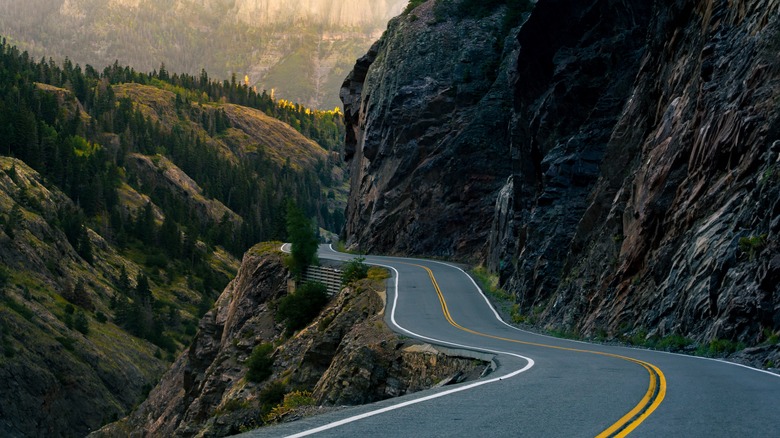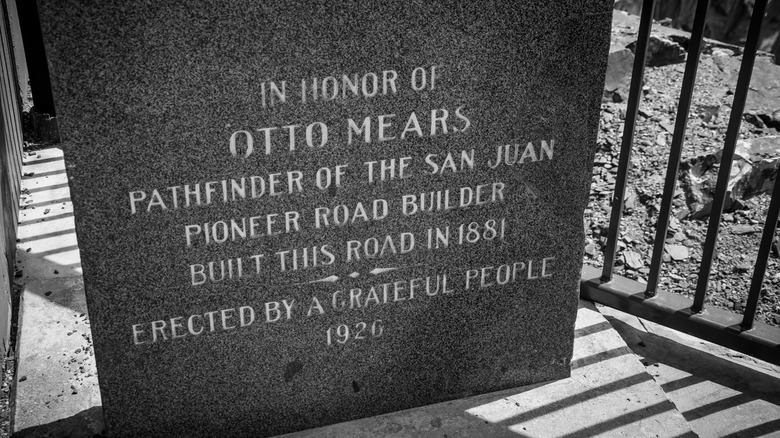Why Is This Dangerous Colorado Road Called The Million Dollar Highway?
Traveling through the high-octane altitudes of the Colorado Rockies, one encounters winding highways across vast swaths of unadulterated natural beauty pockmarked here and there by small towns. Those highways serve as a lifeline for the towns they connect. Yet with cars navigating inches from sheer cliffside drops on gearbox-grinding grades, Rocky Mountain roads can be as treacherous as they are beautiful .
In a state known for some of the curviest roads is a stretch of asphalt referred to by locals as the Million Dollar Highway. Officially a stretch of U.S. Route 550, it carves a path 20 miles long through the San Juan Mountains and is bookended by the towns of Ouray at its north and Silverton at its south. It has been designated one of the most dangerous roads in America, owing to its sharp switchbacks and hundred-foot drops. Although it sits in the path of 70 avalanche tracks, large sections of the highway are needle-narrow and do not have guardrails, and winter conditions add further hazards for months each year. Despite a 25 mph speed limit, there were 53 crashes on the pass in 2024 alone. The Colorado Department of Transportation disputes the highway's characterization as dangerous and emphasizes that the views are among the best in the region.
Travelers often wonder how such a perilous pass earned such a splendid sobriquet. While the precise answer has been buried beneath the alpine asphalt, several explanations have been put forth over the years. Here are the most common explanations for why this slice of Route 550 became the Million Dollar Highway, as well as which of them line up with the known facts.
The Million Dollar Highway is a mountain-sized embellishment
Rocky Mountain towns often employ charming embellishments that serve as reminders of their historic foundations. Locals in Ouray, the former mining town at the north end of the Million Dollar Highway, have referred to their home as "the Switzerland of the Rockies" since the late 1800s, around the same time the Million Dollar Highway was nicknamed. The story of that colorfully named road is therefore one of embellishment, no matter which version of the story you believe. Numerous explanations have proliferated, their veracity obfuscated by more than a century of retellings like a coat of ice on the highway itself.
According to some, the highway's private owners imposed a large toll on drivers, equivalent to about $150 in today's money, and locals got in the habit of saying the highway cost a million dollars to drive on. Others claim that the highway's hazardous terrain proved so harrowing for people arriving in one of the municipalities it connects that they would dismount their cars and — in yet another hyperbolic turn of phrase — declare their intention never to make the drive again, not even for a million dollars.
The most literal origin story is that the road cost a million dollars, but even here, there are different opinions. Some say a million dollars in precious ore was used as part of the road fill, while others claim the route incurred that amount in construction costs due to the difficulty of building it over the Red Mountain Pass and Uncompahgre Gorge. Today, tourism offices in the surrounding towns will tell you it's because of the "million-dollar views," even as they caution drivers not to get distracted by the scenery.
Which story of the Million Dollar Highway is the most factual?
The history of the Million Dollar Highway clarifies which of its legends have some truth to them. Now part of the U.S. interstate system on one of the longest highways in America, the road was built by industrialist Otto Mears in 1883. A Russian-born Jewish immigrant, Mears settled in Colorado after fighting for the Union during the Civil War. He became a prolific road builder, recognizing the trade his routes could facilitate. Not all were built in the public interest, however. In addition to charging exorbitant tolls, Meers built a road to facilitate the forced removal of the White River and Uncompahgre Utes from the area. More to our aims here, among the toll roads he built was an ambitious highway from Silverton up to Ouray — now known as the Million Dollar Highway.
The history would seem to support the claim that exorbitant tolls led to the road's tongue-in-cheek nickname. Charging between $1 and $5, depending on the number of wagons and horses, Mears profited to the tune of $100,000 or more, according to some sources, a staggering $3.2 billion in today's money. The costs stirred up so much resentment that Colorado ultimately took possession of the highway. However, there's no hard proof that anyone called it the Million Dollar Highway because of the tolls. Some sources claim the name actually originated at a planning meeting when one man's math led to a million-dollar figure in total contracts. Others claim with equal confidence that locals were so enamored of the road's construction that they assumed it had cost its titular sum. Ultimately, the mystery of its name remains part of its million-dollar charm.


